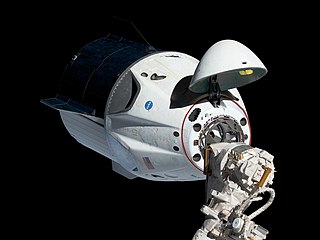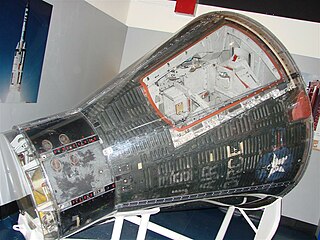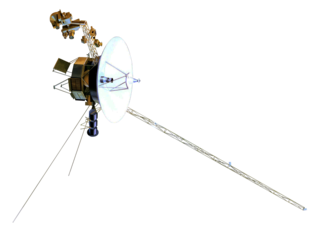 W
WBoeing Starliner Calypso is a space capsule manufactured by Boeing and used in NASA's Commercial Crew Program. On 20 December 2019 Calypso launched on the Boeing-Orbital Flight Test mission, an uncrewed test flight of Starliner to the International Space Station. The spacecraft was scheduled to dock to the ISS and then return to Earth following a week in space, although due to several software issues the spacecraft was unable to rendezvous with the station and landed following two days in space, this resulted in Boeing needing to schedule a second Orbital Flight Test which is currently targeted for December 2020.
 W
WDragon C208 is the first Cargo Dragon spacecraft, and the first in a line of International Space Station resupply craft which replaced the Dragon capsule, manufactured by SpaceX. The mission is contracted by NASA under the Commercial Resupply Services (CRS) program. It flew for the first time on the CRS-21 mission on 6 December 2020. This was the first flight for SpaceX under NASA's CRS Phase 2 contract awarded in January 2016. This is also the first time a Cargo Dragon will be docked at the same time as a Crew Dragon spacecraft. This mission used Booster B1058.4, making it the first time NASA authorized SpaceX to launch a NASA payload on a reflown booster.
 W
WCommand module Columbia (CM-107) is the spacecraft that served as the command module during Apollo 11, which was the first mission to land humans on the Moon. Columbia is the only spacecraft of the Apollo 11 mission that returned to the Earth.
 W
WCrew Dragon C204 capsule was part of Crew Dragon flight vehicle SN 2-1 manufactured and operated by SpaceX and used by NASA's Commercial Crew Program. Used in the uncrewed Demo-1 mission, it was launched atop a Falcon 9 rocket on 2 March 2019, arriving at the International Space Station on 3 March 2019. It was the first orbital test flight of the Dragon 2 spacecraft. The spacecraft was unexpectedly destroyed on 20 April 2019 during a separate test when firing the SuperDraco engines at Landing Zone 1.
 W
WCrew Dragon Endeavour is a Crew Dragon spacecraft manufactured and operated by SpaceX and used by NASA's Commercial Crew Program. It was launched into orbit on top of a Falcon 9 rocket on 30 May 2020 and successfully docked to the International Space Station (ISS) on 31 May 2020 as part of the Crew Dragon Demo-2 mission. It was the first crewed flight test of Dragon capsule, carrying Doug Hurley and Bob Behnken. It is the spacecraft used in the first crewed orbital spaceflight from the United States since STS-135 in July 2011 and the first crewed orbital spaceflight by a private company. On 2 August 2020 it returned to Earth. The spacecraft was named by Hurley and Behnken after the Space Shuttle Endeavour, which they flew into space during the STS-127 and STS-123 missions, respectively. The name Endeavour is also shared by the command module of Apollo 15.
 W
WCrew Dragon Resilience is a Crew Dragon spacecraft manufactured by SpaceX and built under NASA's Commercial Crew Program (CCP). It is currently docked on orbit to the International Space Station (ISS) on the Crew-1 mission after launch at 00:27 UTC on November 16, 2020 delivering the four additional members of Expedition 64 to the three already on station. With crew prompting, Resilience docked autonomously to the station at 04:01 UTC on Day 2 of the mission marking the first crewed operational flight of a Crew Dragon craft and the Commercial Crew Program.
 W
WCuriosity is a car-sized Mars rover designed to explore the Gale crater on Mars as part of NASA's Mars Science Laboratory (MSL) mission. Curiosity was launched from Cape Canaveral on November 26, 2011, at 15:02 UTC and landed on Aeolis Palus inside Gale on Mars on August 6, 2012, 05:17 UTC. The Bradbury Landing site was less than 2.4 km (1.5 mi) from the center of the rover's touchdown target after a 560 million km (350 million mi) journey. The rover's goals include an investigation of the Martian climate and geology, assessment of whether the selected field site inside Gale has ever offered environmental conditions favorable for microbial life, and planetary habitability studies in preparation for human exploration.
 W
WThe Dragon 2 DragonFly was a prototype suborbital rocket-powered test vehicle for a propulsively-landed version of the SpaceX Dragon 2. DragonFly underwent testing in Texas at the McGregor Rocket Test Facility in October 2015. However, the development eventually ceased as the verification burden imposed by NASA was too great to justify it.
 W
WThe SpaceX Dragon C106 is a Dragon space capsule built by SpaceX. It is the first reused SpaceX Dragon capsule to be reflown into space, having its second launch in 2017. C106 was first used on CRS-4, and then used again for the CRS-11 and CRS-19 missions. It was the second capsule after C108 to be used a third time, marking a milestone in SpaceX's drive to reduce space launch costs through reusing hardware.
 W
WThe SpaceX Dragon C108 is a Cargo Dragon space capsule built by SpaceX. It is the first Dragon capsule to be flown three times, having its third launch in 2019. C108 was first used on CRS-6, and then used again for the CRS-13 and CRS-18 missions. It was the first capsule to be used a third flight, marking a milestone in SpaceX's drive to reduce space launch costs through reusing hardware.
 W
WThe Dragon Spacecraft Qualification Unit was a boilerplate version of the Dragon spacecraft manufactured by SpaceX. After using it for ground tests to rate Dragon's shape and mass in various tests, SpaceX launched it into low Earth orbit on the maiden flight of the Falcon 9 rocket, on June 4, 2010. SpaceX used the launch to evaluate the aerodynamic conditions on the spacecraft and performance of the carrier rocket in a real-world launch scenario, ahead of Dragon flights for NASA under the Commercial Orbital Transportation Services program. The spacecraft orbited the Earth over 300 times before decaying from orbit and reentering the atmosphere on 27 June.
 W
WGemini SC-2 was the second NASA Project Gemini full-up reentry capsule built. This McDonnell Gemini capsule was the first space capsule to be reused, flying twice in suborbital flights. SC-2 flew on Gemini 2 and OPS 0855 flights. The capsule is currently on display at the Air Force Space and Missile Museum at Cape Canaveral Air Force Station.
 W
WLunar Module Eagle (LM-5) is the spacecraft that served as the crewed lunar lander of Apollo 11, which was the first mission to land humans on the Moon. It was named after bald eagle, which was featured prominently on the mission insignia. It flew from Earth to lunar orbit on the command module Columbia, and then was flown to the Moon on July 20, 1969, by astronaut Neil Armstrong with navigational assistance from Buzz Aldrin. Eagle's landing created Tranquility Base, named by Armstrong and Aldrin and first announced upon the module's touchdown.
 W
WMars Helicopter Ingenuity is a robotic helicopter that is planned to be used to test the technology to scout targets of interest on Mars, and help plan the best driving route for future Mars rovers. The small drone helicopter is planned for deployment in 2021 from the Perseverance rover as part of the NASA Mars 2020 mission.
 W
WPerseverance, nicknamed Percy, is a car-sized Mars rover designed to explore the Jezero crater on Mars as part of NASA's Mars 2020 mission. It was manufactured by the Jet Propulsion Laboratory and was launched on 30 July 2020, at 7:50 a.m. EDT, and is scheduled to land on Mars on 18 February 2021.
 W
WVoyager 1 is a space probe that was launched by NASA on September 5, 1977. Part of the Voyager program to study the outer Solar System, Voyager 1 was launched 16 days after its twin, Voyager 2. Having operated for 43 years, 4 months and 2 days as of January 8, 2021 UTC [refresh], the spacecraft still communicates with the Deep Space Network to receive routine commands and to transmit data to Earth. Real-time distance and velocity data is provided by NASA and JPL. At a distance of 152.1 AU from Earth as of December 11, 2020, it is the most distant human-made object from Earth ⊕.
 W
WVoyager 2 is a space probe launched by NASA on August 20, 1977, to study the outer planets. A part of the Voyager program, it was launched 16 days before its twin, Voyager 1, on a trajectory that took longer to reach Jupiter and Saturn but enabled further encounters with Uranus and Neptune. It is the only spacecraft to have visited either of these two ice giant planets. Voyager 2 is the fourth of five spacecraft to achieve the Solar escape velocity, which will allow it to leave the Solar System.